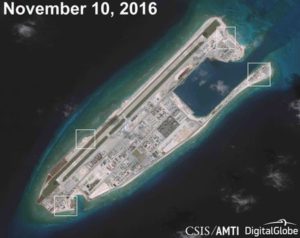by WorldTribune Staff, December 14, 2016
New satellite imagery shows China has installed anti-aircraft and anti-missile systems on the seven artificial islands it constructed in the South China Sea.
The Asia Maritime Transparency Initiative (AMTI) said it had been tracking construction of “hexagonal structures” on Fiery Cross, Mischief and Subi reefs in the Spratly islands since June and July, according to a Reuters report on Dec. 13.

“This is militarization,” AMTI director Greg Poling said. “The Chinese can argue that it’s only for defensive purposes, but if you are building giant anti-aircraft gun and close-in weapons systems (CIWS) emplacements, it means that you are prepping for a future conflict.
“They keep saying they are not militarizing, but they could deploy fighter jets and surface-to-air missiles tomorrow if they wanted to.”
China has built military length airstrips on Fiery Cross, Mischief and Subi islands.
“It now seems that these structures are an evolution of point-defense fortifications already constructed at China’s smaller facilities on Gaven, Hughes, Johnson, and Cuarteron reefs,” AMTI said, citing images taken in November.
“This model has gone through another evolution at (the) much-larger bases on Fiery Cross, Subi and Mischief reefs.”
Beijing continues to insist it has no intention to militarize the islands in the strategic trade route, where territory is claimed by several countries.
Satellite images of Hughes and Gaven reefs showed what appeared to be anti-aircraft guns and what were likely to be CIWS systems to protect against cruise missile strikes, AMTI said.
Images from Fiery Cross Reef showed towers that likely contained targeting radar, AMTI said.
“These gun and probable CIWS emplacements show that Beijing is serious about defense of its artificial islands in case of an armed contingency in the South China Sea,” AMTI said.
“Among other things, they would be the last line of defense against cruise missiles launched by the United States or others against these soon-to-be-operational air bases.”
U.S. President-elect Donald Trump, who takes office on Jan. 20, has indicated he may adopt a tougher approach to China’s assertive behavior in the region than President Barack Obama.
